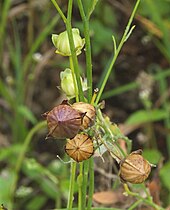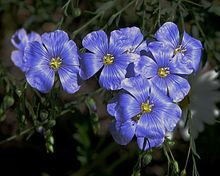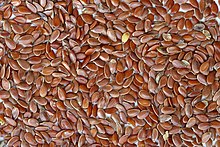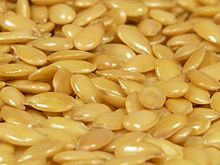(Linum usitatissimum)
Flax seeds produce a vegetable oil known as flaxseed or linseed oil, which is one of the oldest commercial oils, and solvent-processed flax seed oil has been used for centuries as a drying oil in painting and varnishing
 |
| Capsules |
 |
| Flowers |
 |
| Brown Flax Seeds |
 |
| Golden Flax seed |
Part used: seeds
Properties: emollient, demulcent, laxative, mucilage, nutritional.
What it affects: lungs, throat, intestines, and stomach.
Preparation and amount:
Infusion: steep 5-15 min and drink 1 cup every day.
Decoction: take 2 oz. 3 x a day
Tincture: drink 15-40 drops 3 x a day or as needed
Fluid extract: take 15-30 drops 3 x a a day or as needed.
Powder: drink 10-20 #0 capsules (60-120 grains) once a day
Purposes:
Flaxseed is very even more mucilaginous than slippery elm and useful for a variety of problems. It is better than olive oil, for the purposes for which it is used.
Internally, flaxseed is used for asthma, bronchitis catarrh, constipation, diarrhea, enteritis, flatulence, hemorrhoids, stomach ulcers, pleurisy, and lung, and chest problems. It is also good for intestinal inflammations.
Eating the seeds intact is good for constipation. Take1-2 tbsp. whole seeds ans swallow with lots of water if necessary. Then eat stewed prunes.The seeds swell up in the intestines, encouraging elimination by increasing the volume of fecal matter.
To eliminate gallstones, take 1 1/2 tbsp. flaxseed oil and lie down on your left side for half an hour. The gallstones will pass into the intestines and be eliminate from there.
Externally, flaxseed is good in poultices for sores, boils, inflammation, and tumors.Combine it with slippery elm for boils, oozing sores, and burns.
Caution: It is best to avoid flaxseed if you have diverticulitis.
Plant Description:
Flax is an erect annual plant growing to 1.2 m (3 ft 11 in) tall, with slender stems. The leaves are glaucous green, slender lanceolate, 20–40 mm long and 3 mm broad. The flowers are pure pale blue, 15–25 mm diameter, with five petals; they can also be bright red. The fruit is a round, dry capsule 5–9 mm diameter, containing several glossy brown seed shaped like an apple pip, 4–7 mm long.
In addition to referring to the plant itself, the word "flax" may refer to the unspun fibers of the flax plant.
No comments:
Post a Comment